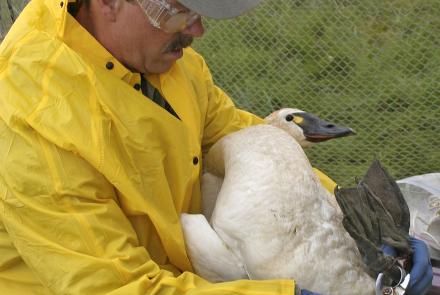Man-made Aurora
Proof that scientists really do understand the direct cause of the Northern Lights comes from a series of rocket experiments performed in Alaska, Hawaii, Virginia and elsewhere in the world.
The first experiment was at the NASA rocket base at Wallops Island, Virginia, in 1969. An electron gun, a device capable of shooting out beams of high-speed electrons, was placed in the nose cone of a rocket and lofted high above most of the atmosphere. Using gas jets, the rocket payload was rotated until it pointed downward along the direction of the earth's magnetic field, which, even as far south as Virginia, points more downward than northward.
When all was ready, bursts of electrons were shot from the gun. Traveling at speeds near twenty thousand miles per hour, the electrons followed the direction of the magnetic field and penetrated the atmosphere. There they struck the atoms and molecules of the atmosphere and made them glow, producing the first controlled man-made aurora. The thin, pencil streaks of aurora that resulted were too weak to be seen by eye. Still they were recorded by sensitive ground-based television systems developed by the University of Alaska and placed around the launch site.
Having proved that auroras can be generated by man, the experimental team next moved to Hawaii for an even more difficult experiment. Another electron gun was flown up from a launch site on Maui. This time, the gun was aimed upward instead of down.
Shooting from the gun, the electron beams sped away from the earth, following the magnetic field direction upward. Reaching high above the equator, the electrons then curved to follow the magnetic field back downward into the Southern Hemisphere. They produced an aurora recorded by the University of Alaska television cameras carried aboard jet aircraft flying above the South Pacific Ocean, east of American Samoa.
Having shot electrons from the Northern Hemisphere to the Southern, the experimenters had proved that beams of electrons would follow along the direction of the earth's magnetic field for great distances. And, of course, they verified again that when the electrons hit the atmosphere, they generated an observable aurora.
Several similar experiments have been performed from the Poker Flat rocket range near Fairbanks. Soviet and French-Soviet teams also have generated artificial auroras over Russia, using similar rocket devices. When NASA's space shuttle flies, it too will perform more artificial aurora experiments.
Aside from giving straightforward proof of how auroras are caused, such experiments help to solve some of the mysteries that still remain about the aurora and about other complex phenomena occurring in our universe. What goes on in producing an aurora is similar to the processes taking place in the stars and in the vast reaches of space between them.



